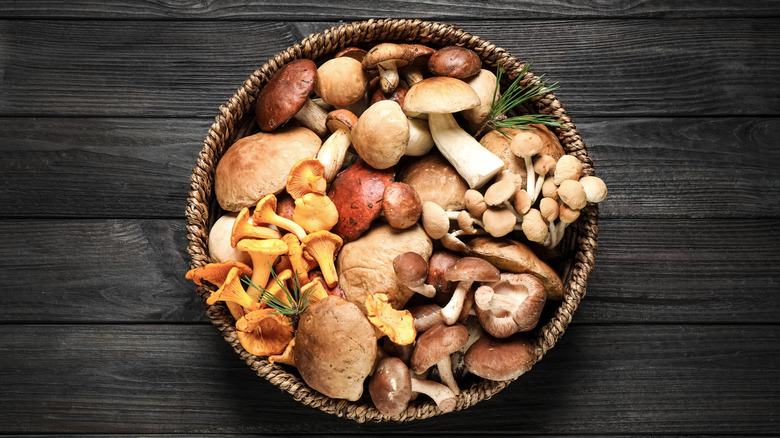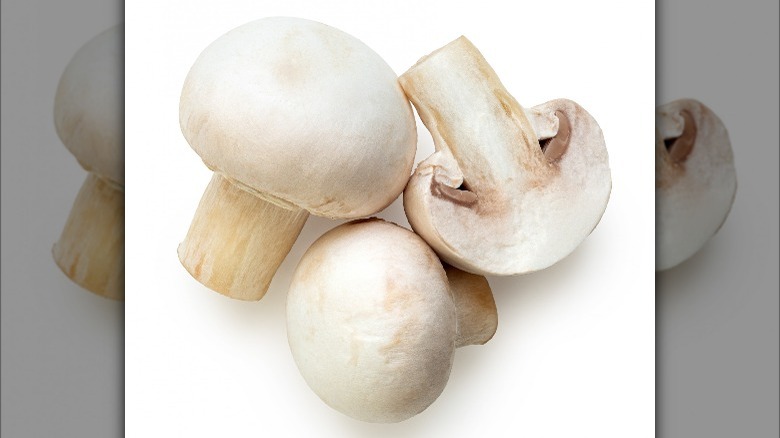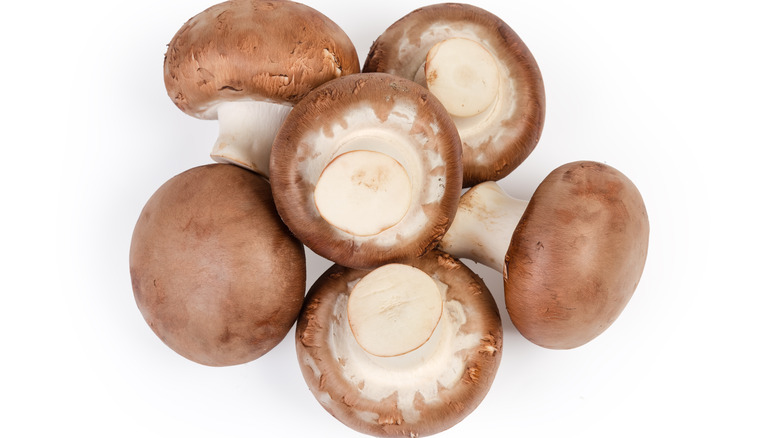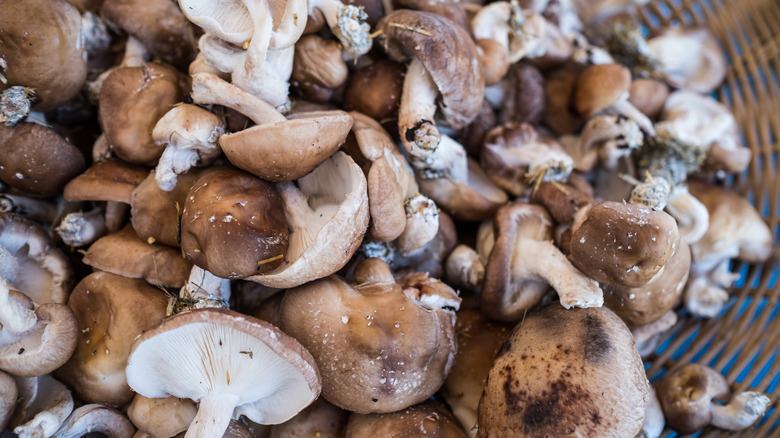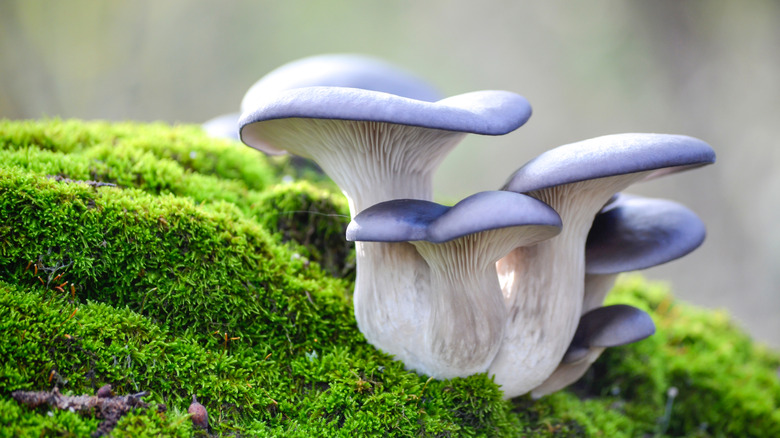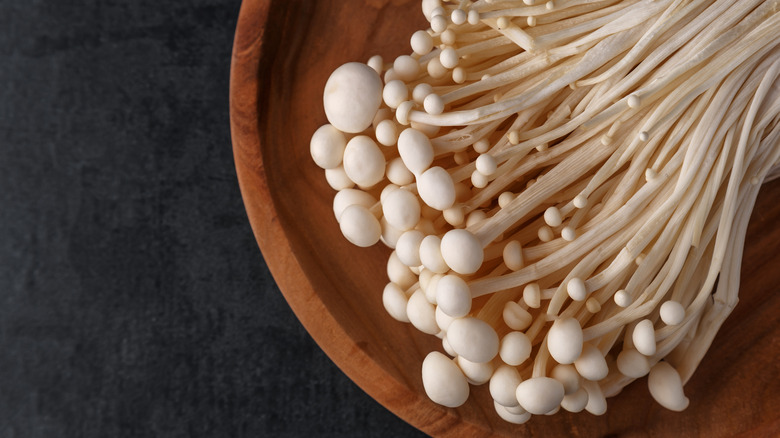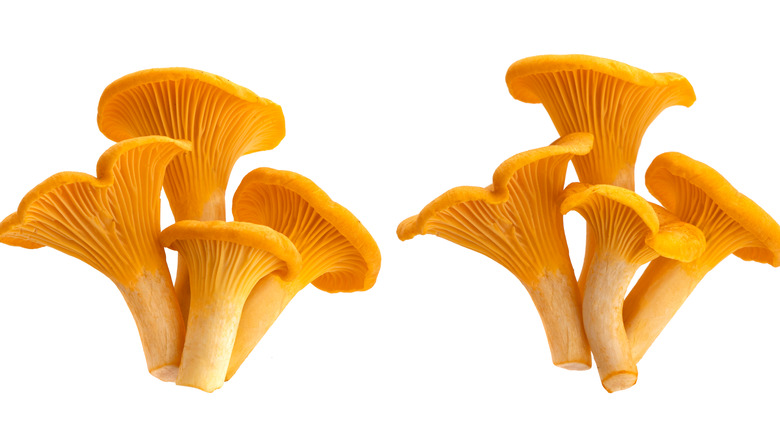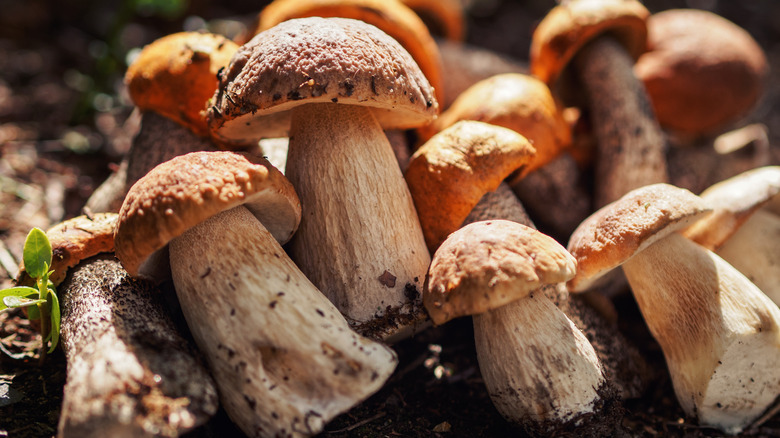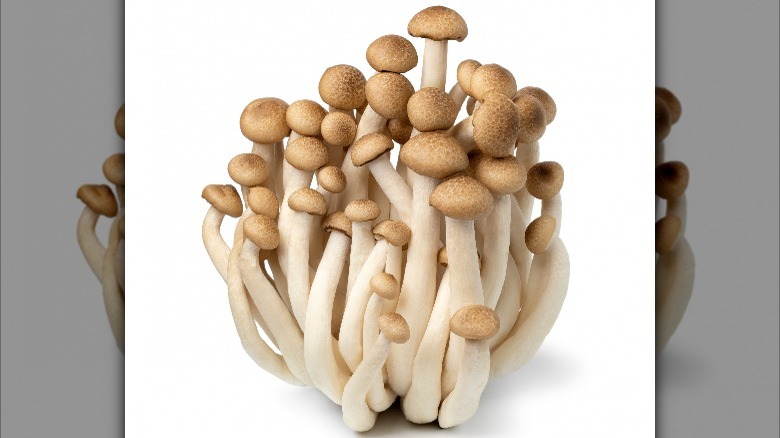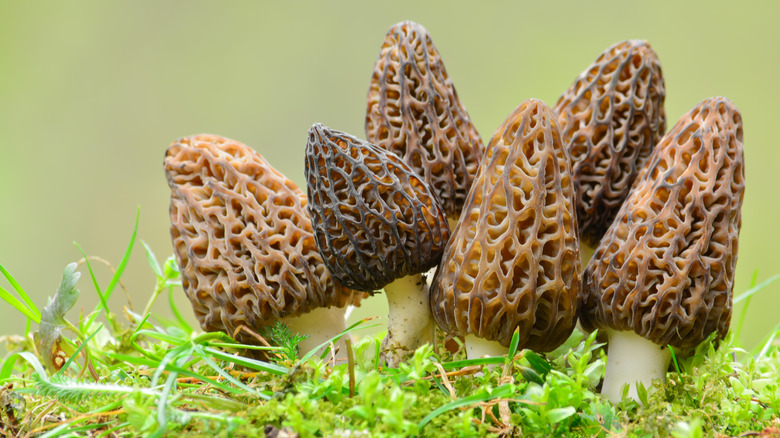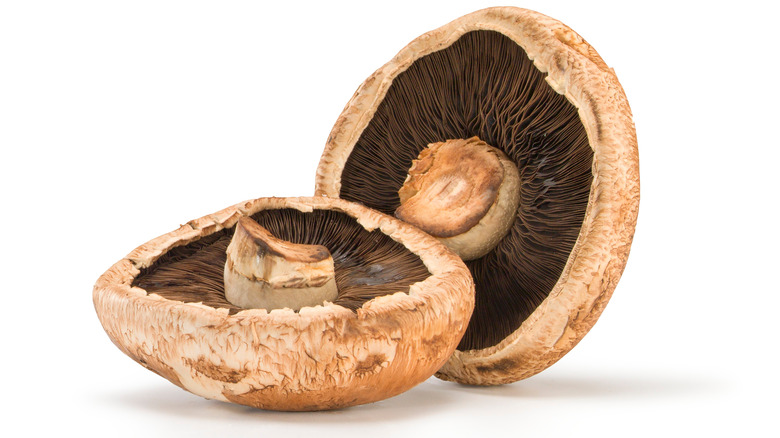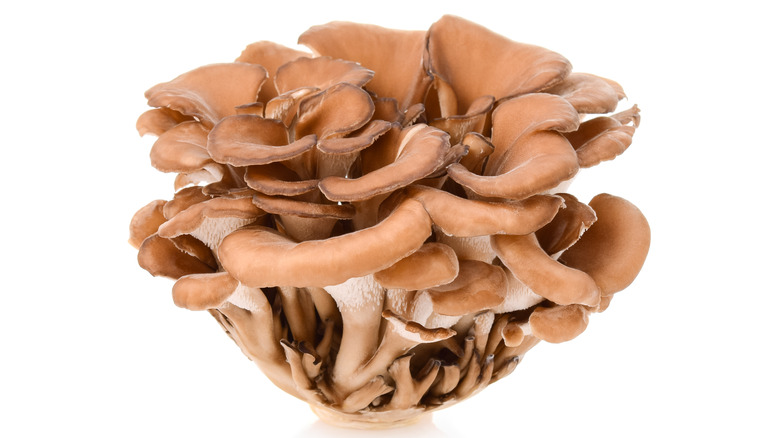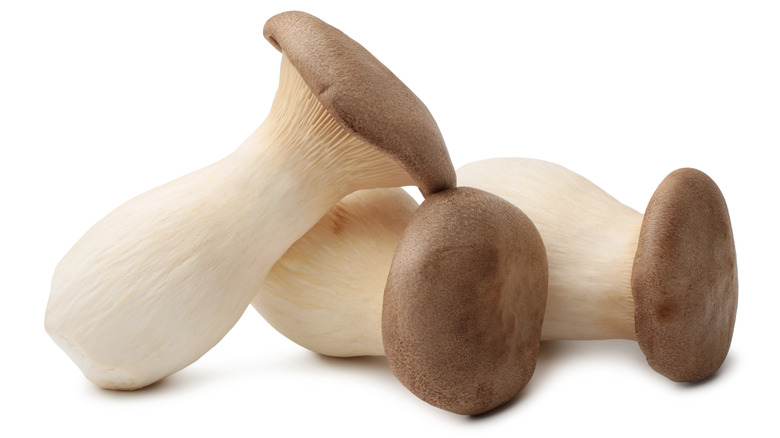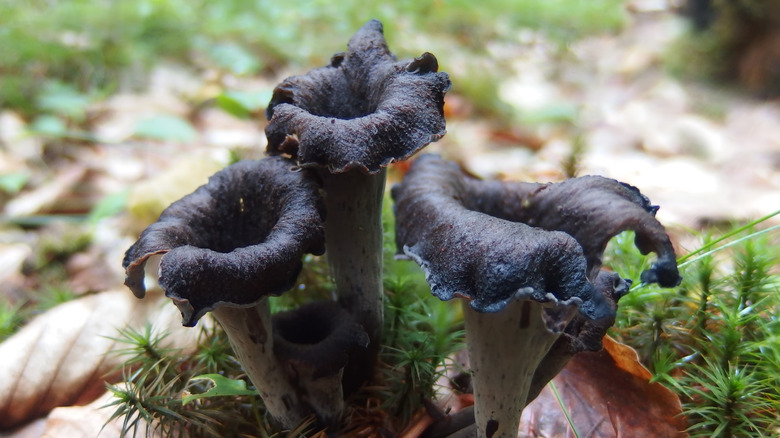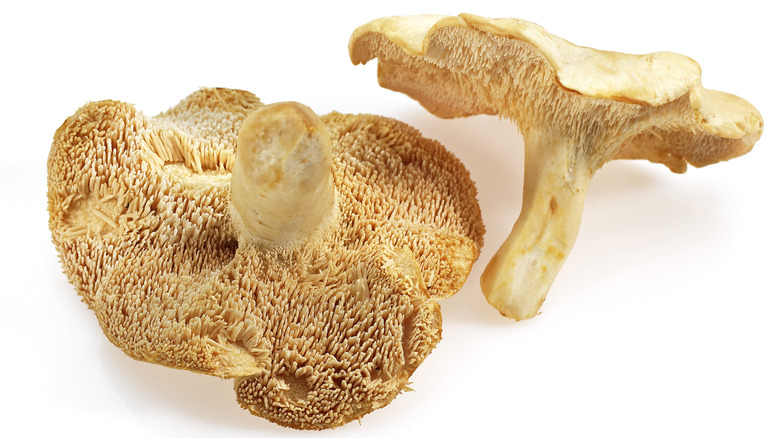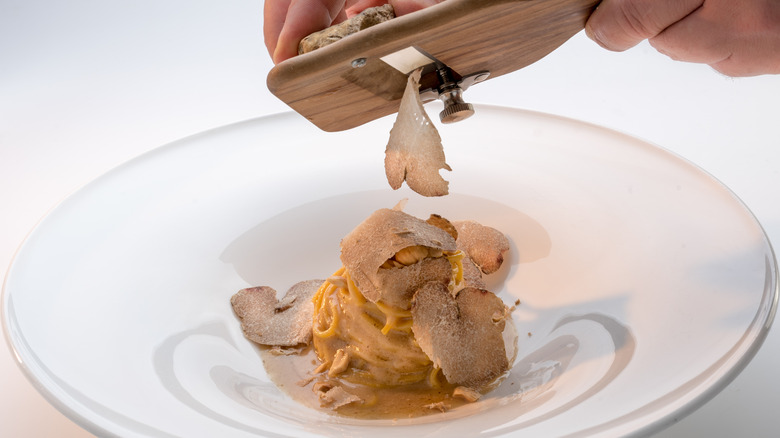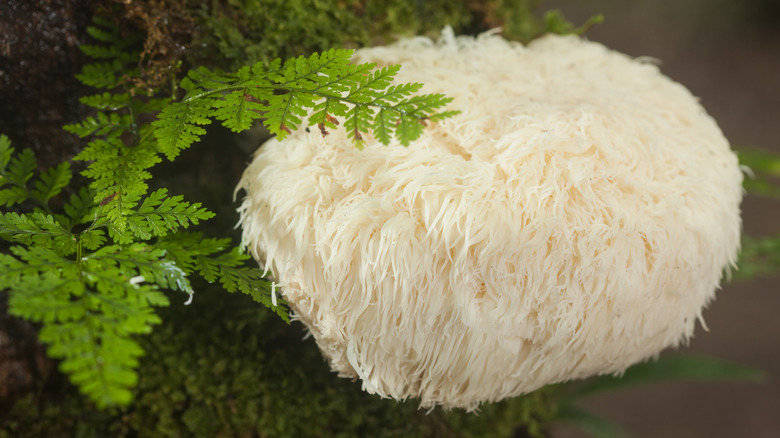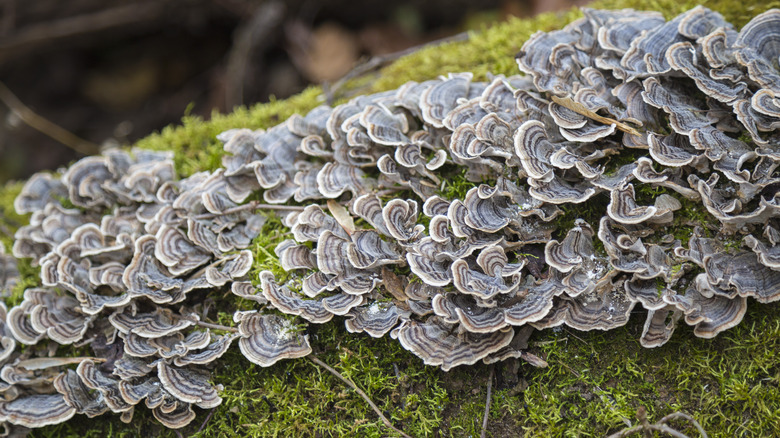17 Types Of Mushrooms And What They Are Used For
The vast world of mushrooms can be overwhelming for a novice forager or eater. Ranging from delicious to deadly, foraged mushrooms can be dangerous if they aren't picked by a trusted and experienced mushroom hunter. But they are also one of the culinary world's delicacies, providing unique textures and tastes to recipes of all kinds. Because of their strong flavor and decent protein content, mushrooms are often used as a meat substitute for vegetarians and vegans. Moreover, they can provide a boost in flavor to both meat-heavy and meatless stews, sauces, and soups.
Common across all cuisines and cultures, mushrooms are highly coveted around the world and can range from affordable to dizzyingly expensive. If you've historically stuck to the basics of what's on offer in your grocery store produce section, now's your chance to branch out a little. We've rounded up 14 different kinds of mushrooms to choose from — there's something for everyone here. Yes, that goes for even the most diehard fungus haters among us.
White button
White button mushrooms are the perfect choice for everyday cooking. They're easy to work with, readily available, and oftentimes delicious. According to Mushroom Appreciation, white buttons also last longer than your average mushroom species, so you can keep these in your fridge for about a week before they go bad.
White button mushrooms are versatile, too, meaning that it's easy to throw them into any recipe that needs a little extra umami flavor. The most basic approach to cooking this mushroom variety is sautéing them with oil over medium-high heat, but other preparation methods yield just as tasty a meal. Mushroom Appreciation recommends grilling, marinating, or topping off meat or pizza with these little fungi.
Like many raw mushrooms, white buttons do contain small amounts of carcinogens. According to the Vegetarian Times, these toxins are eliminated with heat, so cooking your mushrooms before eating them is generally a good practice. Still, you'll often come across raw mushrooms in salads, and you should rest assured that ingesting a few here and there is unlikely to do lasting damage. But if you want to be extra safe, you can always sauté them for a few minutes — they'll taste better, anyway!
Cremini
Cremini mushrooms have a lot in common with both white button and portobello mushrooms — in fact, they're actually all the same species. White button mushrooms are harvested earlier than creminis, which gives the latter time to develop their brown color and more complex flavor (via Kids Are Great Cooks).
Similar to white button mushrooms, creminis can be cooked in a variety of ways and taste good with practically everything. You can eat all parts of the mushroom, from stem to cap. Toss them raw or cooked into salads, stews, or pasta dishes, where they can add complexity and depth to any dish.
One simple way to cook creminis is to roast them. A Couple Cooks recommends roasting them at 450 F for 10 to 12 minutes tossed with some oven-ready olive oil and seasonings like garlic powder and salt. Once they're cooked, you can add them to meals or eat them plain.
Shiitake
As one of the most popular mushrooms in the world, shiitakes add a deep, earthy flavor to meals. Shiitake mushrooms grow in the wild on rotting wood logs, where their caps can get as big as 10 inches across, according to MasterClass. These mushrooms have been used for cooking in Japan and China for centuries, while in recent years, scientific advances have made it easier to grow them. Today, shiitakes you find at the grocery may have been grown on corncobs, sunflower seed hulls, or other food waste products (via MasterClass).
When cooking shiitakes, it's important to first cut the stems from the caps. According to MasterClass, the stems take a bit longer to cook, and if they aren't given enough time to soften, they'll be hard to chew. If you want to use both the stems and the caps in one dish, begin cooking the stems for a few minutes, then add the caps.
Sautéing or stir-frying are the easiest ways to cook shiitakes, both of which utilize the stovetop and a little oil. MasterClass recommends storing these mushrooms in a damp kitchen towel in the refrigerator to keep them fresh for as long as possible.
Oyster
Oyster mushrooms, also known as pearl oyster or tree oyster mushrooms, are one of the more common mushrooms you'll find in the grocery store, along with white buttons and shiitakes. They grow naturally on trees in humid climates and are used most often in Chinese, Japanese, and Korean cuisines. According to live eat learn, oyster mushrooms have a milder flavor than some other mushrooms, and they tend to be thinner and more delicate, too. Oyster mushrooms are named for their shape — the caps aren't flat, but wavy and rounded like oyster shells.
Like with most mushrooms, it's best to clean oysters using a dry or damp towel. Try to avoid soaking them in water, as the mushroom can potentially absorb the liquid (though Alton Brown disagrees on that point).
It's best to avoid eating oyster mushrooms raw. Cooking these mushrooms enhances their savory flavor and diminishes the metallic taste of the raw version. Cook these the same way you'd cook most mushrooms, such as in a sauté or stir fry, though braising works well, too. This technique brings out the oyster mushroom's velvety texture.
Store these mushrooms in a paper bag in the refrigerator, where the paper will absorb some of the water, making your oysters last longer than they would in humidity-trapping plastic.
Enoki
Enoki mushrooms are most commonly found in specialty grocery stores. While they're becoming more common in American supermarkets, it's still somewhat rare to come across these clustered mushrooms.
Enoki mushrooms have very long stems and small caps, making them look like clumps of grass or noodles. They're popular in Japanese and Chinese cuisine, and you've likely come across them in ramen or hot pot dishes. According to A Couple Cooks, these mushrooms have a mild, savory flavor, while the stems can be crunchy if they're eaten raw.
When cooking enoki mushrooms, you'll want to keep in mind that they cook quickly due to their smaller size (via Yummy Mummy). A saute or stir-fry method works well here or, if you're making ramen or another stew, you can add the enokis during the last few minutes of cooking. Store these mushrooms as you would others — in a paper bag in the fridge, to avoid moisture buildup.
Chanterelle
Gold in color with a complex, earthy flavor profile, chanterelles are one of the best mushrooms you can eat. Chanterelle caps have a wavy, vase-like shape that leads to the stem, which is the same color as the cap. According to Mushroom Appreciation, these mushrooms are found only in the wild, where they form mutually beneficial relationships with the trees of the forest, a phenomenon known as mycorrhiza. That means that even the chanterelles you find in the supermarket were likely hand-picked in the forest, and probably not grown in a lab or greenhouse.
Cooking chanterelles can be difficult due to the amount of moisture they've collected in their porous skin. Real Tree recommends cooking off some of that water initially. Per Mushroom Appreciation, you should also avoid washing them if possible, since adding water to chanterelles will only increase the risk of them turning out waterlogged and soggy on your plate. To reduce the moisture, heat the mushrooms in a dry pan for a few minutes, allowing the water to dissipate before you add in butter, garlic, or other ingredients.
According to Kitchen Stories, fresh chanterelles can last up to 10 days in your fridge. Keep them in a paper bag or cover them with a towel for the best results.
Porcini
Porcini mushrooms are a common ingredient in many types of French and Italian cuisine. If you've ever had savory mushroom risotto, porcinis likely played a role in that delicious dish. According to MasterClass, these mushrooms grow naturally in forests across the Northern Hemisphere of our planet, in places as varied as North America, Europe, and Asia.
Porcini mushrooms have thick stems and brown caps that can grow up to a foot in diameter, per GroCycle. However, it's far more likely that the porcinis you'll find in stores or restaurants are just a couple of inches across their caps. MasterClass notes that these mushrooms are renowned for their nutty taste, which makes them a popular ingredient in meats, sauces, and broths. They are often used in vegetarian recipes to pack extra flavor into meatless meals.
To wash porcinis, you'll want to use a paper towel. Try to avoid washing them with water, as these mushrooms don't hold up well to excess moisture. Store them in a loose paper bag in the refrigerator and use them as soon as possible, given that they only last a couple of days in the fridge and taste best when they're nice and fresh.
Shimeji
Characterized by their long stems and rounded caps, shimeji mushrooms often grow on beech trees in grass-like clumps. They are either brown or white, both types of which are edible and taste the same, according to Diversivore. They tend to be crunchier than other mushrooms varieties. Even when cooked, they typically retain a crisp texture. And you should cook them, as it's best to avoid eating shimejis raw, given that they can be difficult to digest uncooked. Besides, they have a bitter taste when plucked straight from the tree.
When cooked, shimeji mushrooms have a mild flavor with hints of savory nuttiness. They are often used in Japanese cuisine, in soups, noodles, and salads, per Just One Cookbook, and are especially popular in hot pot recipes. If you're looking for a more unique way of preparing mushrooms, shimejis can even be pickled!
According to Diversivore, shimeji mushrooms are often sold in breathable plastic cellophane wrap. And, if left in these containers, they can keep for several weeks in your refrigerator. Otherwise, they'll last about five days in an opened container.
Morel
Morel mushrooms grow primarily in the springtime and can only be found in the wild, where they grow around the base of decaying trees in warm, wet climates (via Better Homes and Gardens). Because they are so difficult to grow commercially, morels tend to be expensive. But if you can afford them, you'll soon understand why they're so highly coveted. As Allrecipes notes, their complex flavor and meaty texture make them the perfect mushroom to cook with.
Morels have a unique shape and texture. Their caps are usually longer and taller than those of most other mushrooms, but they can also appear more bulbous. The skin of these caps is intricately textured in a pattern that looks like a honeycomb. When you cut into a morel, you'll find both the stem and the cap are hollow. If you find a "morel" that isn't hollow on the inside, don't eat it! Some morel look-alikes are poisonous.
Try cooking morels with just a little butter, which enhances the natural flavors in the mushroom — perhaps a risotto would be the best way to use up those precious morels. You'll want to use fresh morels as quickly as possible, as too much time in the fridge may change their unique texture. To make them last longer, you can dry them in the sun and store them in an airtight container for up to six months (via Allrecipes).
Portobello
Portobello mushrooms are actually the same species as creminis, just fully matured. According to Specialty Produce, the average cap size for portobellos is 15 centimeters, but this may vary greatly. Underneath the cap lies dark brown-colored gills, which in larger portobellos can be quite prominent.
Portobellos are one of the most popular mushrooms in the United States, where they make up about 90% of commercial mushroom production (via Specialty Produce). Because of their size, these mushrooms are a popular meat alternative, securing their place on burger menus for the vegetarian crowd.
According to Rhubarbarians, it's best to clean these by washing them right before cooking. This way, you can remove the dirt from the mushroom without giving the water too much time to soak in. You'll want to trim the stem or cut it off entirely and, depending on what you're using the mushroom for, it might be a good idea to peel the first layer of skin from the cap while you're at it. Doing so may help to create a better texture for portobello burgers or steaks.
If you purchase these mushrooms in a plastic-wrapped container, you'll want to transfer them to a paper bag or wrap them in a paper towel within a container as soon as you can. That way, they'll last a bit longer.
Maitake
Maitake mushrooms, also charmingly known as hen of the woods, are one of the most striking mushrooms when it comes to appearances. They grow in clusters reminiscent of feathers and usually sprout up at the base of trees, according to A Couple Cooks. These mushrooms are popular in China and Japan, though they grow in North America and Europe as well.
The taste of a maitake mushroom is just as bold as its exterior. This mushroom has a woodsy flavor and is best cooked low and slow with smoky flavors. Maitakes also taste great fried, as their spindly ends soak up oil well and become deliciously crunchy without losing their savory flavor. When you cook a maitake mushroom, you'll likely need to break it apart a bit, since the clusters can be quite large.
These mushrooms don't have a very long shelf life, however, so be sure to eat them up promptly. The best way to store them is in a paper bag in the fridge, like most mushrooms. Maitakes can also be kept at room temperature in a loosely covered container unless you live in a particularly dry climate.
King trumpet
According to MasterClass, king trumpet mushrooms are a type of oyster mushroom with a tantalizing texture that's similar to seafood like calamari or scallops. King trumpets have thick white stems and brown caps and are the largest of all oyster mushrooms (via A Couple Cooks). They are cooked using the whole mushroom, stem included, and are prevalent in Mediterranean food, as well as Chinese, Japanese, and Korean cuisines.
King trumpets can be found in most grocery stores and, compared to porcinis, they're relatively cheap. If you're up for an adventure, you can even grow them yourself! All it takes is a little humidity, mushroom spawn, and sawdust.
King trumpet mushrooms taste earthy and savory, according to A Couple Cooks. They are often used as a meat substitute for vegan and vegetarian dishes and, due to their thick stem, they hold up well to all manner of preparation techniques like slicing, shredding, and frying. They make an excellent vegetarian pulled pork (er, mushroom?) sandwich!
When cooking, make sure to score the stems of the bigger mushrooms. This ensures they cook evenly and soak up all the flavor from your oil. A Couple Cooks notes that, because these mushrooms are usually grown on logs or trees, they don't usually need to be washed. Instead, you can simply brush off any visible dirt with a towel. Like so many other varieties, you should store these mushrooms in the refrigerator in a paper bag.
Black trumpet
Black trumpets, similar in shape to chanterelles, are a true culinary delicacy. As Forager Chef describes, they are one of the most flavorful mushrooms in the forest, with a unique taste that carries a hint of smokiness (via Mushroom Appreciation). Native to Europe and North America, they tend to grow in shaded parts of the forest, where their black hue makes them particularly difficult for foragers to spot (via Organic Facts).
Black trumpets are shaped like, well, trumpets. All told, they look very similar to chanterelles, but they are black instead of brown and they lack the characteristic gills of chanterelles. Instead, their skin is typically smooth and sometimes wrinkly. These mushrooms are generally small and very delicate (via Outdoor News).
When cooking black trumpet mushrooms it's best to choose flavors that won't overpower the flavor of the mushroom. You want to highlight the natural deliciousness of black trumpets, not distract from it. They taste great as a main ingredient in pasta or risotto. You might have trouble finding these unique mushrooms in the grocery store, but you will hopefully have better luck at a local farmer's market. Alternatively, you can purchase dried black trumpet mushrooms online or at some specialty food stores.
Hedgehog
Hedgehog mushrooms look somewhat like chanterelles but, according to The Mushroom Forager, they're easier to identify. That makes these fungi much safer for novice mushroom foragers who are hunting for these yummy treats in the forest. Hedgehog mushrooms have pale-colored caps that range in size from 4 to 20 centimeters. They're usually somewhat strangely shaped, with rounded but uneven caps. The underside of the cap is covered in spindly tooth-like spikes (via Galloway Wild Foods).
Hedgehog mushrooms are meaty and earthy according to Forager Chef. They taste great sautéed in oil or butter, with a little salt added to the mix. The texture retains some crunch even when cooked and, thanks to the sturdy size, hedgehog mushrooms can hold up to harsher cooking or preservation methods, such as frying or freezing (via Mushroom Collecting). You can also use them in some savory muffins. Hedgehog mushrooms will also stay fresh longer than most mushrooms – you can keep them in your fridge for up to two weeks, according to Wineforest Wild Foods.
Truffles
Chances are, even if you're a mushroom hater, you've heard all about truffles. They're extremely popular — and extremely expensive — fungi that grow underground. And because they're quite difficult to grow, many of them are foraged in nature. Their exclusivity is definitely reflected in the cost, and USA Today reports that the price per pound can sometimes reach thousands of dollars. Yes, you read that right ... thousands.
Of course, not everyone is willing to pay those prices, and that's totally understandable. But taste a fresh truffle, and you'll get what all the hype is about. They're richly flavored with a garlic umami touch that will have you begging for more. Black truffles from France seem to be more common in restaurants, but if you're lucky, you'll also get a chance to try white truffles, many of which come from the Piedmont region of Italy.
Unlike most mushrooms, you don't cook truffles. Instead, they're generally shaved over pasta or other rich dishes to provide an intense flavor that works well with anything creamy. While truffles aren't generally an ingredient you would eat on an everyday basis, they're perfect for a celebration when you really want to go all out. Have some fresh truffles? Try to eat them as soon as possible although they'll last for about two weeks in the fridge if you can't get through them all at once (per The English Truffle Company). Wrap them in a damp paper towel and seal them in an airtight container for maximum freshness.
Lion's mane
Lion's mane mushrooms are unlike any fungus you've ever seen before. In fact, the first time you see one, you may not even immediately recognize it as a mushroom. It's called lion's mane because of its thin hair-like strands that hang down, making it instantly recognizable. These mushrooms are bright white, which makes them stand out in the forest. And according to VeryWell Mind, these medicinal mushrooms (no, not that kind of medicinal) show many health benefits, including providing those who consume them with important antioxidants.
There's a good chance you've never cooked with lion's mane before, and it may seem intimidating at first. However, you can cook this mushroom very simply and it is delicious when it's fried. The stringy strands get nice and crispy, and the light earthy flavor becomes even more pronounced once they've been browned. It may be difficult to get your hands on some lion's mane, but if you're lucky enough to find any, you shouldn't let them go to waste.
If you've managed to source lion's mane, then store them in the fridge outside the produce drawer (per A Couple Cooks). It's important to keep them in a paper bag, as the material will allow for enough airflow to prevent the mushrooms from going bad too quickly.
Turkey tail
Turkey tail mushrooms are almost as eye-catching as chanterelles, growing like fans in clusters with brightly colored stripes running along their edges. They look like rock formations, except you've never seen a rock formation like this before. Turkey tails look kind of off-putting, so you may not realize that they're completely edible. But if you're foraging with an expert and you happen to find them, you know you're in luck.
According to Om Mushrooms, they can provide a variety of health benefits, which makes them popular functional mushrooms. However, the taste is less mushroomy than you may expect, and some people aren't too fond of it. Generally, they are mixed into broths where some of their flavor is covered up by other ingredients, but some companies even sell coffee drinks with added turkey tail mushrooms.
These may not become a staple in your kitchen, but you should definitely give them a try. If you have some fresh turkey tail mushrooms on hand, you should either use them as soon as possible or dry them, per GroCycle. Dried turkey tails last indefinitely, so they're a great ingredient to have stocked in your pantry.
